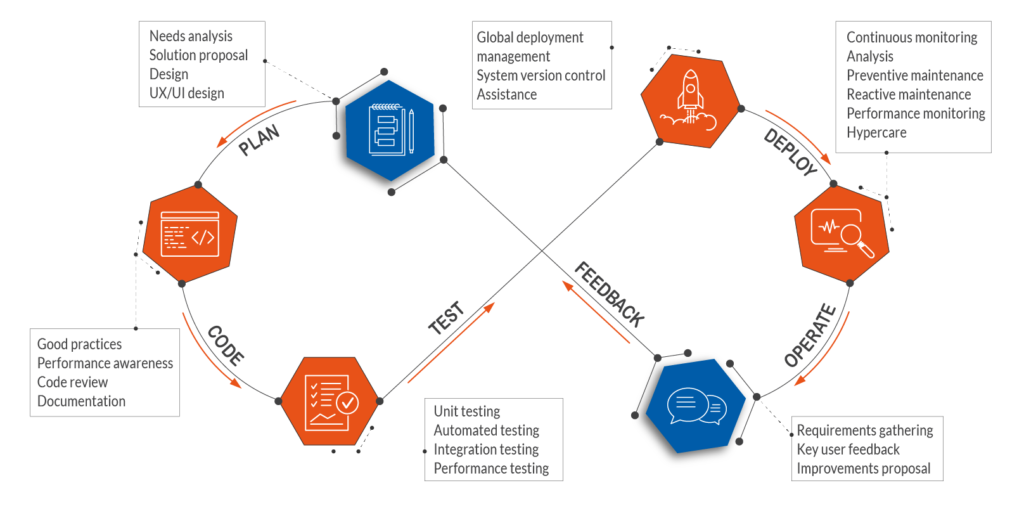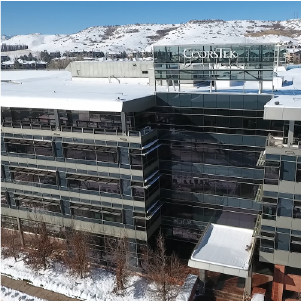

How DevOps enhances MES application development and maintenance
Releasing new functionalities while maintaining system stability has always been a hit-and-miss affair for manufacturers and always with more misses than hits. Even with the rise of agile methodologies, operations and development teams remained stuck in a vicious cycle of poor communication and wasted resources.
It’s quickly becoming apparent that the traditional approach to manufacturing software development creates more problems than solutions in the current climate. Deploying MES applications to increase operational efficiency, improve quality, and provide traceability across the entire product life cycle suddenly loses its appeal when dealing with the aftermath of the “big bang” releases and disruptions they cause to the production process. No wonder manufacturers actively seek alternatives to speed up the software delivery process, ensure system stability, and deliver more frequent and impactful releases.
Such an alternative already exists. The DevOps approach is taking the software development world by storm. Today, we’re taking a closer look at how the DevOps model can improve the deployment and maintenance of MES applications.
What is DevOps, and how does it work?
DevOps is a software development methodology that brings people, processes, and technology together to provide continuous value to the organization through frictionless communication, collaboration, and automation. Under the DevOps model, software development is delivered as an ongoing service to ensure the smooth flow of the SDLC (Software Development Life Cycle) and robustness in daily operations.
Traditionally, operations and development teams operated as two separate entities, each working on different application components before merging the code just before the go-live. As you can imagine (or tell from your own experience), this siloed approach leaves very little room for testing to detect bugs and errors to prevent application outages in time.
In a DevOps environment, releasing new functionalities is fast-paced yet controlled through predefined steps and processes that ensure errors are spotted quickly and before they wreak havoc on the shop floor. Since DevOps is about moving the project from requirements to a viable solution “on the go,” its success depends on maintaining a frictionless feedback loop between DevOps, stakeholders, and end-users. Applications are released through the following steps: plan, code, test, deploy, operate, feedback – then, rinse and repeat.
Below is a visual representation of the typical MES DevOps process.

Andea MES DevOps Toolchain Loops
It’s a challenge to create a feedback culture where everyone involved in live operations, from shop floor operators to the Application Maintenance team, communicates discovered problems and contributes to continuous code improvement. That is why Andea’s application maintenance services are not just standard level-1 helpdesk support but more like an extension of your team to get the insider perspective of your business on how the new release could affect each department.
The role of automation in MES DevOps
Automation and seamless cross-departmental collaboration are at the core of any DevOps environment. DevOps relies on automation to:
- Maintain continuous integration, continuous delivery, and continuous deployment (CI/CD) through automating areas such as regressive testing or the release of code changes
- Reduce the risk of human error and introduce consistency across the SDLC by automating repetitive, non-value-added tasks and manual processes
In other words, DevOps automation enables your employees to focus on tasks that bring value long-term instead of fixing minor, daily system bugs and errors.
For example, consider MES automated testing. Under the DevOps model, regressive tests are run after each change to the code to ensure existing functionalities are not affected and the solution performs as expected. That way, vulnerabilities never become fully grown defects, which are exponentially more expensive to fix further down the development process. Now imagine performing those tests manually – you’d need to hire a team of testers to work around the clock to repeat the same tests repeatedly every few weeks.
Benefits of DevOps MES development and application maintenance
Whether you’re looking to enhance your existing or deploy a new manufacturing execution system, there is no shortage of advantages DevOps practices can offer.
Scalability within your reach
Releases delivered in the DevOps environment are frequent and carry less impact on daily operations, resulting in more effective resource management, fewer line stoppages, and low application downtime. Decreased manual input due to automation also enables employees to focus more on innovation and optimizing factory performance, eventually shortening time to market and production cycle time and allowing you to scale production capacity depending on current demand.
More effective and productive teams
The first thing you notice after adapting the DevOps model is the lack of the ‘me’ vs. ‘them’ mentality known all too well when various departments work in silos. As the development and operations teams come together, they create a culture of systems thinking and plan and execute the deployment with full awareness of each department’s vulnerabilities and requirements. Different groups work as one, creating a culture of shared transparency and accountability. Everyone involved in software deployment feels personally responsible and engaged in ensuring the solution continuously delivers value.
Streamlined business processes and daily operations
Developing software using DevOps practices excludes the need for software handoffs to other teams, typical for the waterfall methodology. Since feedback, issues, and opportunities are identified and incorporated in the early stages of the development and in real-time, the continuous chain of delivery is maintained, significantly streamlining the software development cycle and your business processes. Teams are not waiting for one another to either review the code or fix errors, effectively coordinating the release of new functionalities while maintaining build stability.
Once a DevOps, always a DevOps
It’s not that applications released using the DevOps methodology run optimally from the moment they’re ‘live’ and perfectly meet user requirements. That’s not the case at all. Instead, it’s more about the fact that they’re released gradually but frequently, mitigating the risk of causing significant disruptions to the production process should an error occur.
DevOps ensures the design, development, and shop floor teams are all on the same page, providing greater visibility into crucial manufacturing operations. In addition, effective team communication helps to eliminate code flaws quickly and efficiently.
Our MES consultants have great experience in MES application maintenance and development using the DevOps methodology. Please do not hesitate to contact us to discuss how we can apply this experience to your business.
You also might like

Pioneering the Path Forward: Unpacking the CoorsTek Factory Showcase
Pioneering the Path Forward: Unpacking the CoorsTek Factory Showcase The recently culminated CoorsTek Factory Showcase, in collaboration with Dassault Systèmes and hosted at CoorsTek Factory,

CoorsTek Factory Showcase: A Tale of Transformation in Collaboration with Andea and 3DS
CoorsTek Factory Showcase: A Tale of Transformation in Collaboration with Andea and 3DS We’re thrilled to invite you to one of the most anticipated events

Improve your laboratory efficiency and streamlining planning processes
Improve your laboratory efficiency and streamlining planning processes Digital transformation in life science happens continuously, quickly, and in front of our eyes. Changes are driven

Intelligent planning and scheduling for life science manufacturing excellence
Intelligent planning and scheduling for life science manufacturing excellence In today’s world, life science transformation is increasingly more important for environment and has a significant

Agile MES – it’s not as scary as you might think
Agile MES – it’s not as scary as you might think A viable alternative to the traditional waterfall project management methodology, the agile approach quickly

Making Agile MES a Reality with CoorsTek
Making Agile MES a Reality with CoorsTek CoorsTek is the global leader in technical ceramics with over 50 locations worldwide, producing advanced ceramic components for

